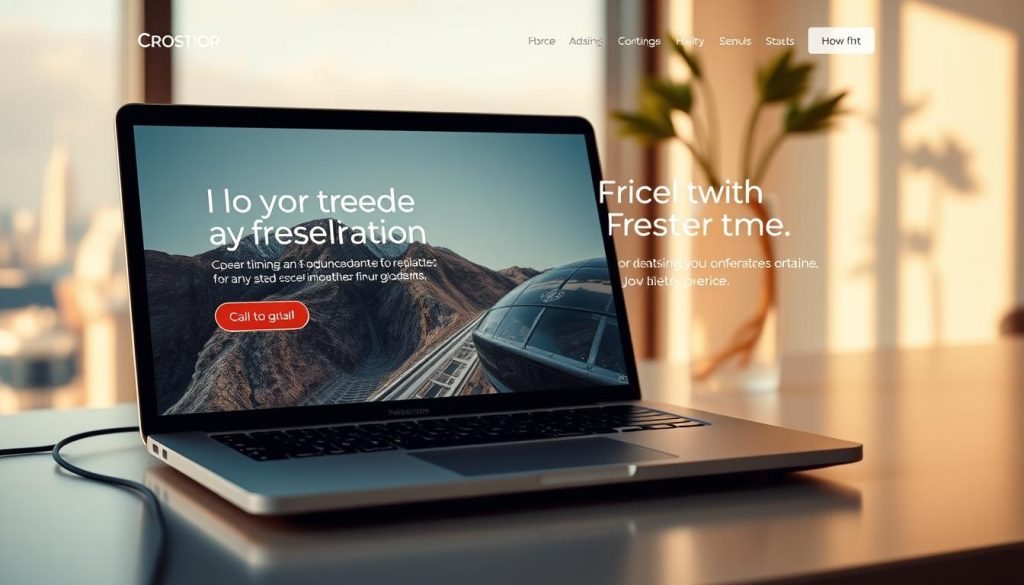Your portfolio is the most controllable way to present your work and win clients fast. In today’s market, a tidy site that loads quickly and shows real examples speaks louder than a long resume.
Start simple: your homepage should state your name, location (France), niche, and core skills in a few clear words. Back that with concise proof points like years of experience or number of projects.
Use a custom domain to boost trust, enable branded email, and make URLs tidy. Choose authentic visuals over generic stock images and keep only your strongest work. Fast hosting and compressed images help keep visitors engaged and reduce abandon rates.
This guide gives a practical, step-by-step path to make sure your website is credible, easy to navigate, and aligned with the clients and projects you want next. You’ll get checklist items, concrete tools, and examples so you can act right away and build momentum.
Table of Contents
Key Takeaways
- Lead with your name, niche, and a short value statement so visitors decide fast.
- A custom domain and branded email signal professionalism immediately.
- Show only your best examples and use real visuals to prove your skills.
- Optimize load time: compress images and pick fast hosting to reduce drop-off.
- Follow practical steps and examples to make your site credible and easy to use.
- Keep the site current: prune weaker items and add fresh, relevant work.
- See a full checklist and examples for inspiration at freelance portfolio essentials.
Understand your goal and audience before you start
Start by clarifying who you want to serve. Identify target clients by industry, company size, and location so your site speaks to the right people. Keep sentences short and messages obvious for visitors who skim.
Define the clients you want and the services you’ll showcase
Write a short services list that matches your strongest skills. Leave off work you no longer want to take. If you’re starting, add personal or unfinished pieces that show drive and taste.
Pick example projects that match the work you want next
Choose 3–5 example projects per target service. Prospects assume you’ll repeat past projects, so pick items that reflect your target style and scope. Use brief, client-centered captions that explain the problem and the result.
- Describe exact clients you want to attract to draw potential clients fast.
- Group examples by skill or industry so visitors find relevant work quickly.
- Keep a small set of writing samples and visuals tailored to current pitches.
For practical tips on researching and knowing your audience, see know your clients.
Set the foundation: domain name, platform, and structure
Choose a clear web address and matching email so every outreach looks professional. Owning your domain name gives you an optimized URL and branded email that builds trust with clients in France and beyond.
Pick a name that is short, easy to spell, and tied to your niche. Use Namecheap to register the domain and set up a matching email to use on proposals and business cards.
Pick the right platform for your goals
Select a platform that fits your skills and speed needs. WordPress (EasyWP + Kadence) gives full control, while Behance, Adobe Portfolio, FolioLink, or Carbonmade let you launch faster.
Plan essential pages and navigation
Start with Home, Portfolio, About, Contact, and a Blog. Keep Portfolio and Contact visible in the top menu and add clear CTAs so visitors can request a quote or call in one click.
- Link from Home to your top projects, and back to Contact.
- Compress images with TinyPNG and choose fast hosting to save time and lower bounce rates.
- Tag projects by service or industry so visitors filter work quickly as you add new case studies.
Craft a concise, original intro that wins potential clients fast
Lead with one clear sentence that says who you are, where you’re based, and what you deliver. This line should sit at the top of the page and link to your best example so visitors see proof instantly.

What to include on your homepage: name, location, skills, value
Show your full name and business location (France) in plain words. Add a one-line value statement that explains the result clients get.
Put a compact proof bar near the hero with numbers like “6+ years • 120+ projects”. List 3–5 core skills that match the work you want. Keep each skill short so the page is scannable.
Use a friendly tone, tight copy, and proof points
Write like you would on a discovery call: friendly and direct. Add one standout example on the homepage with a short caption and a button to view the full case study.
« Quick clarity wins trust. Show who you are, what you do, and a real result — fast. »
- Include a professional photo and authentic visuals.
- Place a single primary CTA: « Request a quote » or « Book a call. »
- Feature one recent blog post or relevant writing sample to support authority.
Keep this page current: refresh numbers, swap weaker samples, and add new testimonials so your homepage always reflects your best work and style.
Design a visual identity that elevates your work
Good design gives your site a calm stage where your work can shine.
Create a compact graphic charter: pick two to three colors, two typefaces, and clear spacing rules. This simple system makes the site feel intentional and helps visitors focus on your work.
Use a professional photo that fits your brand tone and add authentic images from real projects or behind-the-scenes shots. Avoid generic free stock unless you have no alternative, and always verify usage rights.
Tools and inspiration
Look at Awwwards’ Freelance Portfolios for interaction and layout ideas from designers like Diana Toloza and Harry Atkins. Carbonmade supports light animations, Adobe Portfolio ensures cross-device polish, and Canva can produce quick logos or social images.
- Keep layouts minimal so the work has priority.
- Standardize project cards, captions, and buttons for cohesion.
- Ensure accessibility: contrast, readable sizes, and descriptive alt text.
| Feature | When to use | Benefit | Example tool |
|---|---|---|---|
| Embedded micro-interactions | For subtle emphasis | Delivers polish without distraction | Carbonmade |
| Responsive templates | Mobile-first launches | Better conversions on phones | Adobe Portfolio |
| Quick brand assets | No design kit yet | Speeds launch and keeps files optimized | Canva |
| Consistent components | Growing site over time | Keeps pages cohesive and fast | Design system (CSS) |
Design choices should support your goals: highlight CTAs for more inquiries or add editorial white space for prestige. Small, deliberate decisions make a big difference on a portfolio website.
Curate your best work and organize it clearly
Begin with a tight edit: only keep work that proves your core skills today. Audit past projects and remove anything that muddies your message. Weaker pieces lower perceived value; a small, sharp collection raises it.
Showcase depth, not volume. Aim for 3–6 projects per core service or industry so visitors see consistency without scrolling forever.
Show only your best work and relevant samples
Display representative case cards with short summaries and one clear result line. Link high-value items to deeper case studies or related blog content so readers can dive in if they want more context.
Group by skill or industry without overloading categories
Label groups simply (e.g., « B2B SaaS », « Brand Identity », « Editorial Writing »). Keep a single Portfolio hub with a few filters so prospects self-select quickly.
- Keep a visible “What I do” blurb above the gallery to set expectations.
- If you’re starting, include strong self-initiated pieces to show process and taste.
- Maintain a backlog of upcoming additions and rotate out older items as you publish stronger work.
For a practical checklist on how to keep portfolio quality high, see this portfolio building guide.
Add context and credibility to each project
Give every project a short executive summary that shows why it mattered and what changed. Start with the client, the business goal, and the headline result so skimmers get the value quickly.

Structure each case study with a simple flow: client background, goals, constraints, your approach, deliverables, and measurable results.
- Begin with a one-line outcome: conversion lift, leads gained, or time saved.
- Include a short « Role & Timeline » box to clarify responsibilities and duration.
- Pair concise writing with a process image or diagram to show how you worked, not just the final work.
Feature social proof and measurable outcomes
Add client quotes, awards, and press mentions near the results to boost trust. Keep testimonials specific to outcomes or the collaboration experience.
« Traffic rose 40% in three months and we secured two major clients—clear, practical work that delivered results. »
When possible, attach links to published writing samples or press features. Tag each case by skills demonstrated so prospects filter by what they need.
For more real client examples and references, see client success examples.
Optimize user experience: speed, navigation, and contact
Reduce friction: load pages fast and give clients one clear path to reach you. A slow website costs attention; if a page takes longer than about three seconds many visitors leave before they see your work.
Improve loading time with image compression and fast hosting
Compress images with a tool like TinyPNG and serve appropriately sized assets for each container. Use a lean theme and fast hosting so the site feels instant on phones and desktop.
Make it easy to contact you with visible CTAs and forms
Place a sticky CTA that links to Contact and use a short form asking only essentials. Offer a plain email and an optional calendar link so different clients can pick their preferred way to reach you.
- Use descriptive link text to guide users and help SEO.
- Keep headings scannable and content contrast-checked for quick reads.
- Add a brief FAQ to answer timeline and rates questions up front.
| Area | Quick fix | Benefit | Tool |
|---|---|---|---|
| Images | Compress & serve scaled assets | Faster load time | TinyPNG |
| Hosting | Choose fast provider and CDN | Lower latency in France | Managed VPS / CDN |
| Contact | Sticky CTA + short form | More inquiries | Contact form plugin |
| Navigation | Clear header & breadcrumbs | Better discoverability | Simple menu design |
Make it immersive: interactions, transitions, and media
Introduce gentle transitions and mixed media to make visitors stay longer and explore more. Small, purposeful motion helps guide attention without slowing the site.
Use lightweight animations like hover states on project cards, soft image reveals, and scroll highlights. These micro-interactions nudge readers from the hero into your marquee work and CTAs.
Use lightweight animations and transitions to guide attention
Keep animations subtle and fast. Respect reduced-motion preferences and ensure all content is accessible without effects. Test on phones and older devices to protect performance.
Add portfolio extras: previews, downloadable samples, and case studies
Offer quick previews that show the problem, your role, and the result. Add one-page PDFs for busy stakeholders and short clips or interactive embeds to show process from multiple angles.
- Feature a small collection of marquee projects at the top so visitors see your strongest example first.
- Balance motion with clarity: prioritize messaging over flourish when trade-offs arise.
- Look at immersive websites on Awwwards for ideas, then adapt them to your own design and brand.
« Polished transitions and clear previews will keep people exploring your work and help them say yes faster. »
For steps on preparing downloadable samples and a strong online presence, see create a professional online portfolio.
freelance portfolio building for search engines
Make search engines and people agree about your services by using precise, service-led titles and descriptions. Clear meta tags help the right clients find your site in France and abroad.
Write keyword-rich page titles and descriptions that match your services
Use keywords naturally in the page title, H1, and opening paragraph so search engines understand your offering fast.
Write a short description of methods, key results, and locations. Keep it client-focused and honest.
Maintain healthy links and check external showcases regularly
Audit your website quarterly for broken links and outdated external mentions. Broken links harm SEO and trust.
Update press features, replace dead links, and redirect old pages when you change a domain name or structure.
Distribute your portfolio via social, email signatures, and guest posts
Share new projects on LinkedIn, Instagram, and your blog to earn clicks and backlinks. Add the site URL to email signatures and author bios.
Writers should post writing samples on Medium or Contently and link back to the main site to consolidate authority.
| Action | Why it matters | How to do it | Tool |
|---|---|---|---|
| Title & Meta | Improves rankings and CTR | Include service keywords + location | Yoast / Rank Math |
| Link audit | Protects SEO and user trust | Quarterly checks and fixes | Screaming Frog / Ahrefs |
| Content distribution | Drives traffic and backlinks | Share on social and guest post | Medium, LinkedIn |
| Speed & Images | Boosts engagement and rankings | Compress images, use fast host | TinyPNG, EasyWP + Kadence |
« Keep titles descriptive, links healthy, and distribution regular — search engines reward fresh, well-linked sites. »
Conclusion
Wrap up with clarity: keep the end of your site simple and action-driven so visitors know the next step.
Highlight your best work, list one clear contact option, and show the domain name where clients can return. Make sure case summaries explain results in plain language and include one downloadable sample if useful.
Set a routine to update pages, retire weaker items, and refresh titles and meta tags. Share new pieces via social and email so links stay alive and traffic grows.
Use this way of working to create a focused freelance portfolio or a writing portfolio that helps your career grow. Publish, learn, and keep improving — your next inquiry is one strong case away.
FAQ
How do I define the clients I want and the services I’ll showcase?
Start by listing the industries, company sizes, and decision-makers you enjoy working with. Match services to the problems those clients face—copywriting, content strategy, or editing—and choose examples that prove you can solve those problems. Keep descriptions short and targeted so visitors see the fit fast.
How many example projects should I include and which ones should I pick?
Pick 6–12 strong samples that reflect the exact work you want next. Prioritize quality over quantity: choose pieces with clear results, varied formats (blog posts, landing pages, case studies), and relevant industries. Swap older or weak pieces as your collection grows.
How do I choose a professional domain name and matching email?
Use your name or a concise brandable phrase that’s easy to spell and remember. Aim for a .com if possible. Create an email using that domain—info@yourdomain.com or yourname@yourdomain.com—to look professional in pitches and on business cards.
Which platform should I use: a full website or writer-specific tools?
A dedicated website gives control over design, SEO, and long-form case studies. Builders like Squarespace, Webflow, and WordPress are solid choices. Writer-specific tools such as Contently or Clippings.me work for quick setup and samples, but pair them with a personal site for best results.
What core pages should my site include?
Include Home, Work (or Samples), About, Contact, and a Blog or Resources page. Make each page concise: the Home page shows value and CTA, Work highlights case studies, About explains your process and experience, and Contact offers clear ways to reach you.
What should I write on my homepage to win clients fast?
Lead with a short, original value statement: who you help, what you do, and the outcome clients get. Add location or remote availability, 2–3 core skills, and a single proof point (years, notable clients, or a metric). Finish with a prominent call-to-action.
How can I craft a friendly tone and tight copy that converts?
Use plain language, active verbs, and short sentences. Focus on client outcomes, not just tasks. Remove jargon and keep paragraphs brief so readers skim easily. Use testimonials or concrete metrics as proof points.
What visual elements should I use to create a strong identity?
Use a professional headshot, consistent color palette, and two complementary fonts. Keep spacing and margins consistent to let work breathe. Use authentic project images or screenshots rather than generic stock photos.
Where can I find inspiration from award-winning sites?
Browse galleries like Awwwards, Behance, and Dribbble to study composition, typography, and interactions. Note what makes the work clear and memorable, then adapt those principles to your style without copying layouts directly.
How should I organize work by skill or industry?
Use a simple filter or category system: by service (e.g., blog posts, landing pages) or by industry (tech, healthcare). Avoid too many categories—3–5 keeps navigation clean and helps prospects find relevant samples fast.
What should each project description include?
Briefly state the client, the challenge, your approach, and the measurable result. Include role, tools used, and timeline if relevant. Keep descriptions scannable with 2–4 short paragraphs or bullet-style lines.
How do testimonials and press help my credibility?
Short, specific testimonials that name outcomes (traffic, conversions, time saved) build trust quickly. Add logos of clients or press mentions for social proof. Verify permissions before publishing any quotes or logos.
How can I improve site speed and navigation?
Compress images, use modern formats like WebP, and choose a fast host or CDN. Keep menus simple, use clear headings, and place contact CTAs in the header and footer so visitors can reach you from any page.
What contact options should I provide to boost inquiries?
Offer a short contact form, a visible email address, and a calendly or scheduling link for consultations. Include a brief call-to-action on project pages like “Discuss a similar project” to prompt outreach.
How can interactions and media make my site more immersive without slowing it down?
Use subtle CSS transitions, microinteractions, and lazy-loading images or videos. Limit animations to key elements and test performance on mobile; prioritize clarity and speed over flashy effects.
Should I offer downloadable samples or case study PDFs?
Yes. Downloadable one-pagers or PDFs are useful for client reviews and pitches. Keep files lightweight, branded, and focused on results. Gate them behind an email only if you need leads, but offer at least one open sample.
How do I optimize my site for search engines?
Write clear page titles and meta descriptions that match the services you offer. Use descriptive headings, optimize image alt text, and publish regular blog posts or case studies. Monitor backlinks and maintain up-to-date external showcases.
How should I promote my work outside the site?
Share selected projects on LinkedIn, Twitter, and industry communities. Add your site link to email signatures and proposals. Write guest posts or contribute to industry blogs to increase visibility and attract clients.
How often should I update my work and site content?
Refresh samples quarterly or when you finish notable projects. Rotate featured work on the homepage every few months, and keep your About and contact details current. Regular updates help search engines and show prospective clients you’re active.





